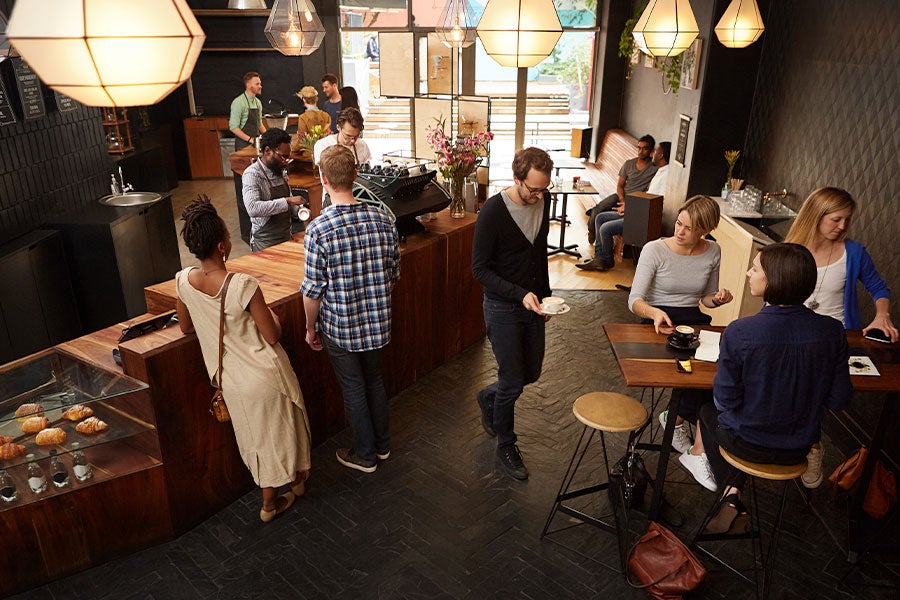By 2025, online food delivery is expected to take up a 21% share of the entire restaurant industry.1 Clearly, consumer demand for takeout food is not going away. To satisfy consumer expectations for quality takeout and delivery food, restaurant operators are responsible for packaging that is functional and keeps food at safe temperatures.
In this guide, we go over food delivery and takeout packaging tips to help you serve the highest-quality product to your guests on a consistent basis. The attention to detail you give to in-house dining must be the same for your takeout and delivery offerings, and we will show you how to get there.
Key Takeaways:
- Your takeout packaging must be functional, keeping takeout and delivery food at safe temperatures and peak quality.
- When choosing the right packaging, think: intentional and specific. Choosing tamper-proof for safety and features such as venting for steam escape all lead to a better end product.
- Packaging is a great opportunity for your brand identity to shine through and gain consumer recognition.
- Using eco-friendly materials can meet customer demand for sustainability.
Takeout & Delivery Food Packaging: The Basics
Takeout and delivery food is delicate and needs to be held at specific temperatures for extended periods of time, while avoiding moisture (including steam). For example, fried foods are best eaten when hot and while still crunchy and full of texture. Poor packaging will cause friend foods to become soggy and less desirable to eat.
For both takeout and delivery foods, your packaging should:
- Hold proper temperature: Your packaging needs to keep hot foods hot and cold foods cold from your kitchen to wherever the customer eats the food, both for safety and optimum quality. Keep foods out of the temperature danger zone—cold foods should be under 40 degrees Fahrenheit and hot foods above 140 degrees Fahrenheit for food safety. Delivery food can also take longer to reach the customer than takeout, so your packaging should ensure your food stays hot and high-quality for longer.
- Preserve texture: When holding food for pickup, packaging should ensure it maintains quality while sitting for an extended period of time.
- Be tamper-proof: With delivery, there is a third party between you and your customer. A 2019 study by US Foods found that one in three delivery drivers admitted to stealing food from customer orders, so your packaging should be tamper-proof.
- Offer a complete dining experience: Both takeout and delivery orders should reflect your menu in similar quality and how they are meant to be eaten for the customer.
- Be clearly labeled and organized: Takeout customers tend to check that their orders are complete before leaving your restaurant. Clear packaging, labels, or see-through lids can help speed this process.
- Promote your brand: Having packaging that speaks to your brand while also being cost-efficient enough to make a profit.
- Durable: Your final package—the bag—should be able to handle the weight of your foods and have sturdy handles. They should also be comfortable to carry.

Packaging Difficult Takeout & Delivery Foods
Not all food ingredients are treated equally. These are some of the most difficult food items to package for takeout and delivery, with my tips on how to package them to preserve their temperature and texture from your kitchen to your customers.
French Fries
French fries are very difficult to package because they are best when hot and crisp. They also have a small surface area, so they lose heat quickly and can become soft in minutes. The best way to package French fries is to place them in a ventilated container or a fry cone like the ones used by fast food restaurants. If fries are sealed, the moisture from the steam they generate can leave them mushy.
The best takeout and delivery packaging for French fries are cone-shaped ventilated or open containers that disperse steam. Place the fry cone in a loosely closed paper bag (that also allows steam to escape), sealing it with a tamper-evident sticker to show customers that no one has sneaked some of their fries.

One of the biggest brands in the world—McDonald’s—has figured out how to successfully serve up to 9 million pounds of French fries a day. So, take note of how bigger players in the space use packaging when making plans for your restaurant.
Soup
Soup can be difficult to package because it is hot and highly spillable. Also, common soup ingredients, like noodles or dumplings, can expand or lose texture over time. So, the first step to packaging soup is knowing what to add to your soup and what to leave out. Below is a list of steps to ensure you are packaging soup correctly and in a way that offers the best texture:
- Ensure the soup is hot before it goes out for delivery or takeout. If it is not hot, then it will not travel well. Bringing to a simmer before storing or packaging is best.
- Leave out items that are fragile or that will ruin as they sit. A perfect example would be to leave the noodles out of pho and package them separately. A customer can add them at home, and keep the eating experience intact.
- Place the soup in a durable paper container, food-grade plastic quart container, or even a soup pouch. Ensure these are leak-resistant and can hold temperature.
- For extra protection, wrap the container in plastic wrap to prevent accidental spilling on the way to a customer’s house.
I always enjoy takeout that allows me to finish some construction at home if the dish requires it. This can take the form of heating up broth for noodles or building my own hard shell tacos. Be mindful and creative in how you package food and what you could ask your customers to finish on their end.
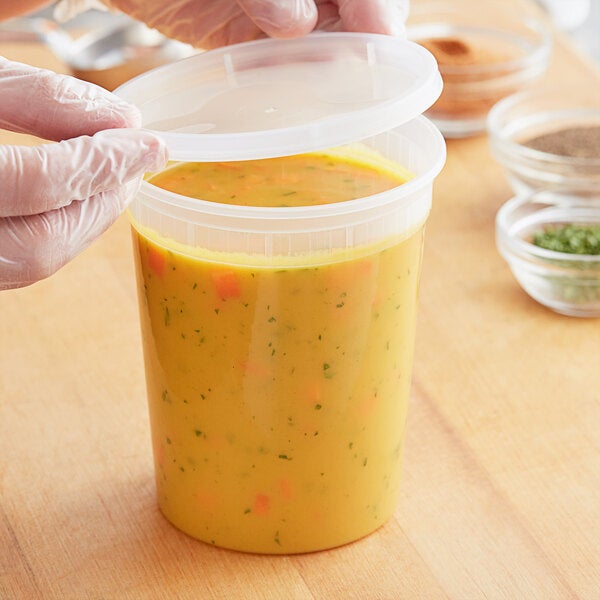
Salad
It is important to package salad in a way that prolongs the freshness of the greens while still offering a delicious eating experience when the time is right. Toppings, certain dressings, and even salt can all make salad greens soggy and lifeless. Below are some key tips on packaging salad:
- Ensure the greens are dry before packaging your salad, and do not dress your salad. Moisture is the enemy of fresh salad greens.
- Package dressings and any other condiments that contain moisture separately.
- Use packaging that allows you to build the salad’s dry components in a way that is appealing and easy to eat. Plastic containers with see-through lids look great visually.
- Place salad greens away from hot products (like cooked proteins), as residual steam can still impact the salad in its container.
- Use bigger containers for salads, and avoid cramming in the greens and bruising them due to lack of space.
- Give the proper utensils to eat the salad, and have enough dressing and other toppings on hand so the customer can mix their salad to their liking.

Breaded Foods
Breaded foods need to avoid moisture at all costs, as a crispy exterior is what customers crave. Additionally, breaded foods need to retain heat. If you have ever eaten a cold mozzarella stick, you will understand why heat retention is so important. Below are some tips on how to package breaded foods:
- Fry or bake breaded foods as close to delivery or takeout time as possible. If frying, ensure any excess oil is shaken off so that it does not pool in the packaging.
- Line the bottom of containers with squares of parchment paper or other moisture-catching material to catch excess moisture or oil.
- Store in ventilated containers—such as paper boxes with vented lids—so that steam can escape.

Do not wrap breaded food too tightly. The surface of breaded food is fragile; let it breathe slightly but have it covered enough to retain temperature.
Pizza
Pizza can be simple to package, but I have seen many restaurants avoid the key materials they need—pizza boxes—to save money or cut down on space. The history of the pizza box is quite interesting, but basically, this box was made in a pretty ingenious way to preserve pizza quality. When not being used, the boxes sit super flat and can be stacked high, not taking up much space. When they are used, they retain heat while ventilating, keeping the integrity of the pizza near perfect for some time. So, the next time you make and package pizza, be sure to use the box designed to keep your pizza the best texture and flavor it can be.
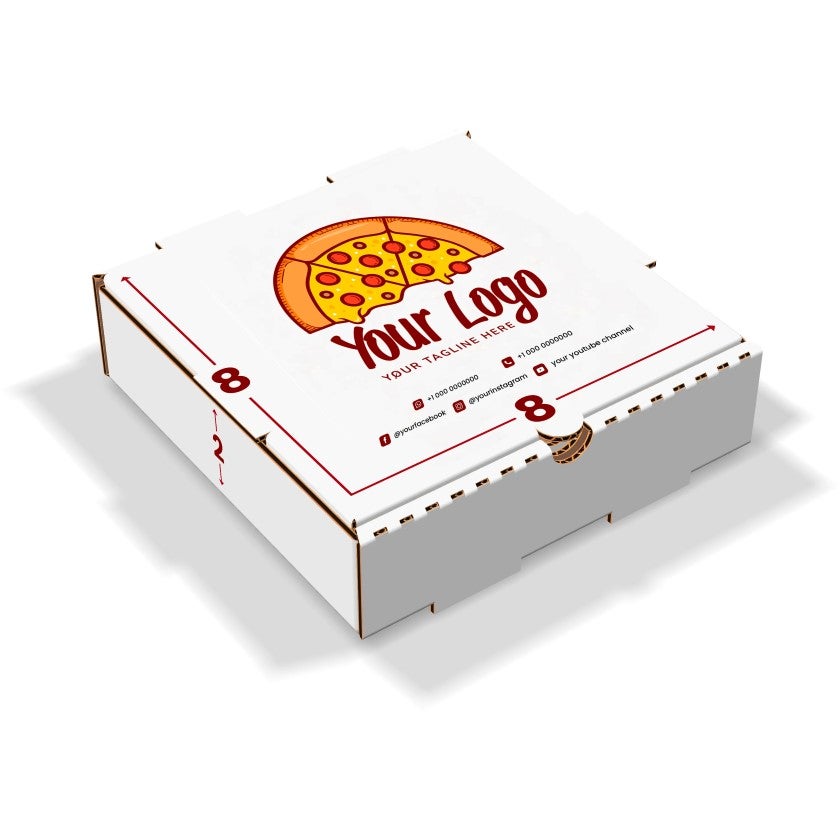
Beverages
Beverages are another tricky item if you are using certain materials, as they can leak and ruin an entire packaged order. The obvious fix is to use sealed bottles or cans when possible to reduce the risk of spillage. But let’s say you are a restaurant that serves boba tea; what will you do then?
First, having leak-proof cups with lids is a need. There are even small little stoppers you can have branded that will fill a straw or sip hole while the product is in transport. Additionally, cardboard cup holders are a great option to keep drinks upright and prevent them from spilling over in a car when being transported. Finally, ensuring the product has the proper holding materials, such as a hot temperature sleeve for coffee cups, is key for the best customer enjoyment.
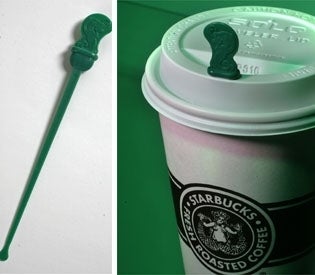
Sides & Condiments
For sides, condiments, and other additions, it is important to make sure they are packaged with the meal they are intended for. For dipping sauces, use small plastic ramekins with leakproof lids to store them properly. For any other sides that may come with the meal, be sure to store them in containers that hold their respective temperatures and containers. Package items that are heavier and sturdier in the bottom of a bag, with lighter items that can be crushed easily on top.

Tips to Elevate Your Food Packaging
As you can tell, food packaging can be fickle and a challenge to get just right. Below are my top five tips for making your food packaging the best it can be:
Brand Your Supplies
Branding your takeout supplies makes for an easy win that can pay dividends in the minds of consumers. The restaurant world is vast and highly competitive—there is something to be said for the restaurant that goes out of its way to have high-visibility branding on its packaging. The same mindset you would assign to your dining room or in-house experience should also be assigned to your packaging.
In a sea of drab, brown napkins and sterile, white plastic straws is where the opportunity for your business lies. Not everything your customer touches needs to be colorful and explode off the packaging material. But utilizing your restaurant’s color, adding logos where needed, and having packaging that is memorable along with your quality product may be all it takes for a customer to choose your restaurant over others the next time they think of ordering food.

Consider Eco-Friendly Options
Consumers now more than ever expect restaurants to operate with the environment in mind. A study by Deliverect found that over half of surveyed diners prefer restaurants that use eco-friendly packaging and single-use plastic.
That being said, the reality of takeout and delivery packaging is that there will be some waste involved in delivering food that is both safe to eat and meets quality expectations. But, knowing how to package your food efficiently and in a way that reduces the number of items actually being packaged will show your expertise as a business owner along with your concern for environmental impact.
Many different types of takeout containers are biodegradable or are made without harmful plastics that take a very long time to break down. On the flip side, you can use containers that customers can wash out and use again if they so choose. In 2024, there are many ways to make decisions that are eco-friendly in the takeout packaging space. Your brand’s reputation will be tested on this, so be sure to keep it in mind.
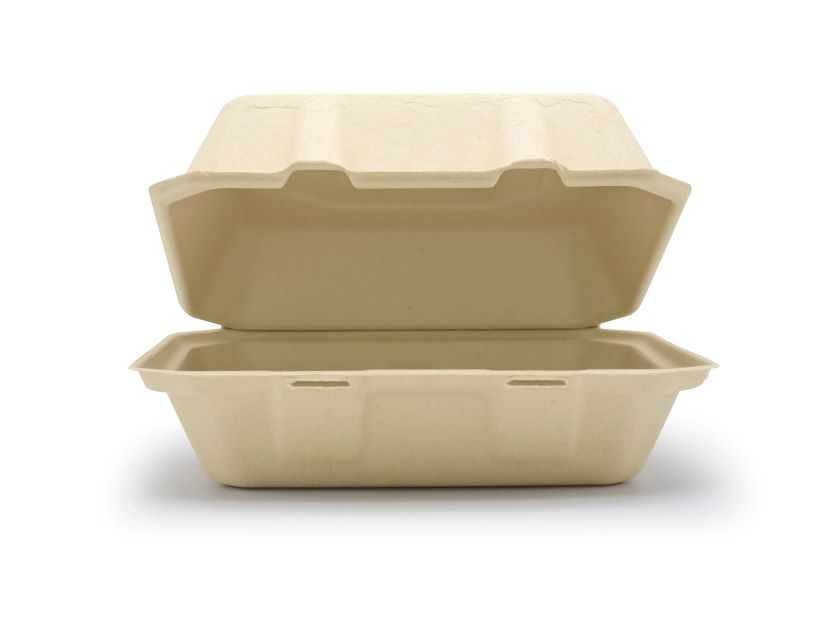
Add Special Offers & Coupons
A great way to drive business and gain repeat guests is to add special offers to your takeout meals in the form of coupons or other deals. Adding a small treat, such as a free drink with their next purchase, entices them to order from you again. It additionally makes your business stand out as one that appreciates its customer base and wants to engage with them time and time again. Small coupons and other offers are small gestures with little bottom-line impact that go a long way in building out a customer base.
Partnering on coupons and deals with local businesses, such as a free coffee at a local coffee shop in return for a free appetizer at your restaurant, are great ways to connect customer bases and bring in more business.
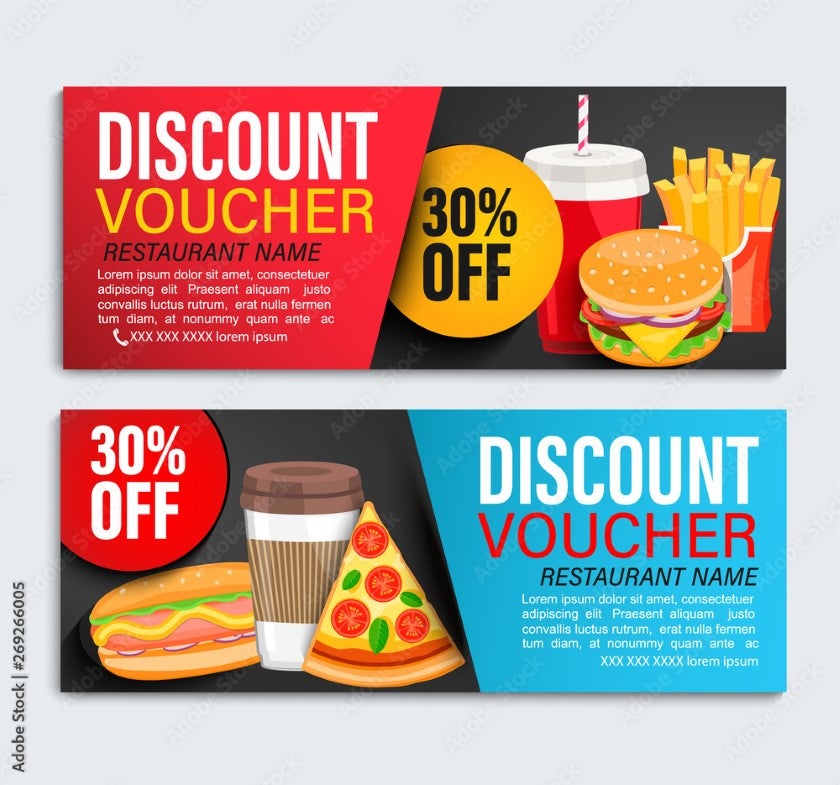
Test Your Packaging
A big mistake that I notice many restaurant owners commit is not testing the product they have bought to transport their food—it is imperative to stress test the packaging materials you have purchased.
Make different menu items and place them in containers, simulate the time they would generally sit, and eat the meal after. Notice how the food tastes, its texture, and the temperature it is at, and note how you can improve it by working backward. This simple yet effective task is key to understanding the best items to offer for takeout or delivery and how you can better them in order to withstand not being served right away in the dining room.
Another key in testing your packaging is ensuring that the size of the packaging works for the food item. If food is crammed or hard to get out of the packaging, then the meal is not at its highest standard and will impact how your customer enjoys it. Ensure your food packaging is big enough to hold the food but also not so tight that it impacts its texture and overall quality. For example, taller sandwiches should be packed in large containers to avoid being squished. And rolls of sushi need to be laid out to hold their presentation.
Your Takeout Menu Does Not Need to Match Your In-house Menu
The last tip I’d like to share is that your takeout and delivery menu does not need to match the menu you serve in your dining room. If dishes simply do not hold up during delivery or travel, do not put them on the menu. It is better to not offer a certain product rather than serve it poorly and prevent a future customer due to bad execution.
Some dishes are just not meant to travel. One example is fish. I worked in a restaurant that served very fresh fish preparations, so we did not offer these menu items to go. It would compromise quality and not deliver on guest expectations. Be smart in what you decide not to offer, but have the confidence that this decision is in the guest’s best interest.
I firmly believe that the best takeout programs only serve the best to-go options that a restaurant has to offer. Test your recipes with employees by sending them home with meals to see how they hold up. This is a great way for them to try the menu while offering feedback.
Frequently Asked Questions (FAQs)
I get a lot of questions about takeout and delivery packaging. These are the most common.
Bottom Line
Takeout and delivery packaging is something every food business should prioritize getting right. When all a customer has to judge you on is food in a container at their home, it needs to be as close to perfect as possible. It is important to understand your food packaging needs, the materials your packaging is made of, and how best to utilize it to ensure your menu is delivered how it is intended. Being able to package food that is both delicious and safe for takeout and delivery comes with proper planning.
- https://www.statista.com/statistics/1170614/online-food-delivery-share-us-coronavirus/ ↩︎


